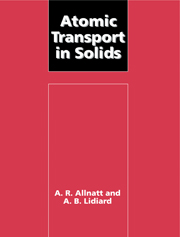Book contents
- Frontmatter
- Contents
- Preface
- List of principal symbols
- 1 Atomic movements in solids – phenomenological equations
- 2 Imperfections in solids
- 3 Statistical thermodynamics of crystals containing point defects
- 4 Non-equilibrium thermodynamics of atomic transport processes in solids
- 5 Some applications of non-equilibrium thermodynamics to solids
- 6 Microscopic theories – the master equation
- 7 Kinetic theory of relaxation processes
- 8 Kinetic theory of isothermal diffusion processes
- 9 The theory of random walks
- 10 Random-walk theories of atomic diffusion
- 11 Transport coefficients of dilute solid solutions – results and applications
- 12 The evaluation of nuclear magnetic relaxation rates
- 13 Theories of concentrated and highly defective systems
- References
- Index
10 - Random-walk theories of atomic diffusion
Published online by Cambridge University Press: 28 December 2009
- Frontmatter
- Contents
- Preface
- List of principal symbols
- 1 Atomic movements in solids – phenomenological equations
- 2 Imperfections in solids
- 3 Statistical thermodynamics of crystals containing point defects
- 4 Non-equilibrium thermodynamics of atomic transport processes in solids
- 5 Some applications of non-equilibrium thermodynamics to solids
- 6 Microscopic theories – the master equation
- 7 Kinetic theory of relaxation processes
- 8 Kinetic theory of isothermal diffusion processes
- 9 The theory of random walks
- 10 Random-walk theories of atomic diffusion
- 11 Transport coefficients of dilute solid solutions – results and applications
- 12 The evaluation of nuclear magnetic relaxation rates
- 13 Theories of concentrated and highly defective systems
- References
- Index
Summary
Introduction
In this chapter we show how to use some aspects of the random-walk theory to describe the macroscopic diffusion of solute atoms (and isotopic atoms) caused by point defects. In doing so we have to handle solute movements and defect movements together, rather than the random walk of just one type of ‘walker’ or ‘particle’, as in the preceding chapter. This presents a more complex problem; nevertheless the approach we shall describe has provided a major part of the subject for many years. It was started by Bardeen and Herring (1952) who drew attention to the fact that the movement of solute atoms by the action of point defects was such that the directions of successive jumps of the solute atom were necessarily correlated with one another for the reasons already presented in Chapters 2 and 5. In Chapter 8 we showed how these correlated movements are handled in kinetic theories. However, it is the calculation of these correlation effects by random-walk theory which has engaged the attention of theoreticians to a considerable extent. Although the consequence of these effects for isotopic self-diffusion may be to introduce only a simple, numerical factor into the expression for the diffusion coefficient, the consequences for solute diffusion can be qualitatively significant, particularly when the motion of the defect is substantially affected in the vicinity of the solute. Under these same conditions qualitatively significant correlations can also appear in the self-diffusion of the solvent. The calculation of these correlation effects is thus an important part of this chapter.
- Type
- Chapter
- Information
- Atomic Transport in Solids , pp. 337 - 379Publisher: Cambridge University PressPrint publication year: 1993
- 1
- Cited by

